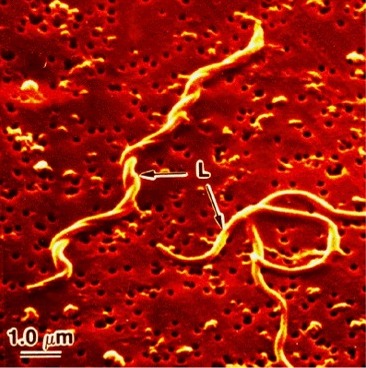
As noted in the "Classification
section", Borrelia burgdorferi are highly motile due to their periplasm flagella, which are located between the cytoplasmic
membrane and outer membrane. While the location of
the flagella root is unique in B. burgdorferi, the flagella
rotates a lot like the general rotation of any bacterial flagella -
it has a "hook" that spins on its axis. The location of the flagella
is what sets B. burgdorferi apart from other
bacteria. Because it is between two membranes, it is able to
"drive the rest of the cell around the long axis" which produces a
motion that allows it to "drill" through tissues to invade its host
(Coburn, J. & Kalish, R., 2000). Generally, B.
burgdorferi
has around seven to eleven flagella all of which allow
the
bacteria
to
"screw
drive"
itself
through host tissue. This
adaptation has allowed Borrelia burgdorferi
to be an effective parasite and has greatly enhanced its mobility.
It is understood that in order for the B. burgdorferi
to survive and thrive, it must adapt to the temperature, acidic
levels, and other conditions of its hosts. The existence of
the B. burgdorferi is dependent upon it sensing its
surrounding and producing specific proteins in order to counteract
conditions it may experience while living in its tick or mammal
host. 
For example, B. burgdorferi produce a lipid
protein combination found on the outer membrane called OspA
(model on left).
This lipoprotien acts as the anchor for B.burgdorferi
to attach within the midgut of the tick. OspA allows B.
burgdorferi
to remain in the gut while the tick digests blood meal. This
adaptation is necessary to ensure that this bacteria species isn't
digested along with the blood meal. However, at the same time,
decreasing in production of OspA allows B. burgdorferi to
detach from the gut and therefore infect the rest of the tick's
body, moving toward the salivary glands. This is when B.
burgdorferi
senses the need for the production of OspC protein because OspC
assists the bacteria in moving from the gut to the salivary glands
(Girschick, H., & Singh, S., 2004). Additionally,
B. burgdorferi produces heat shock proteins which assist with
changes in temperature and also act as chaperones, which assist
organisms in the preservation of their molecular structure while
changing environments. A slime layer also coats the outer wall
of B. burgdorferi allowing it to avoid digestion.
Therefore, it is evident that B. burgdorferi needs to
adapt to its specific environment and does so by producing
specialized proteins.
B. burgdorferi makes
adjustments to its outer wall which senses changes in its
surroundings and in return it communicates the changes that need to
be made. In response the genes activate and deactivate
proteins of B.
burgdorferi's outer surface accordingly. Osps and heat shock
proteins are essential for the survival of B.
burgdorferi. Additionally, because a significant
portion of B. burgdorferi is located on linear and circular
plasmids, the organisms is able to adapt easily to various
environments and also can avoid being destroyed by the hosts immune
system (Schnarr, S., Franz, J., Krause, A., & Zeidler, H.,
2006).
Why is it so successful at adapting to its environment?
The uniqueness of
B. burgdorferi's
chromosomes is thought to greatly contribute to its ability to shift
its outer proteins when the environment changes. B. burgdorferi
has proven to be one of the few bacteria that have linear
chromosomes (as apposed to circular) and also uncoiled plasmids.
These plasmids contain duplicated genes which allows B.
burgdorferi to change its outer protein sequence
in response to its hosts' defense systems. It is also thought
that this allows the organism to educe symptoms within hosts (Karlen,
A., 2000) |